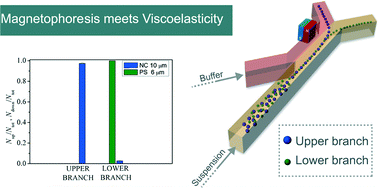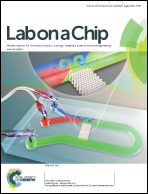Magnetophoresis ‘meets’ viscoelasticity: deterministic separation of magnetic particles in a modular microfluidic device
Abstract
The deflection of magnetic beads in a microfluidic channel through magnetophoresis can be improved if the particles are somehow focused along the same streamline in the device. We design and fabricate a microfluidic device made of two modules, each one performing a unit operation. A suspension of magnetic beads in a viscoelastic medium is fed to the first module, which is a straight rectangular-shaped channel. Here, the magnetic particles are focused by exploiting fluid viscoelasticity. Such a channel is one inlet of the second module, which is a H-shaped channel, where a buffer stream is injected in the second inlet. A permanent magnet is used to displace the magnetic beads from the original to the buffer stream. Experiments with a Newtonian suspending fluid, where no focusing occurs, are carried out for comparison. When viscoelastic focusing and magnetophoresis are combined, magnetic particles can be deterministically separated from the original streamflow to the buffer, thus leading to a high deflection efficiency (up to ~96%) in a wide range of flow rates. The effect of the focusing length on the deflection of particles is also investigated. Finally, the proposed modular device is tested to separate magnetic and non-magnetic beads.


 Please wait while we load your content...
Please wait while we load your content...